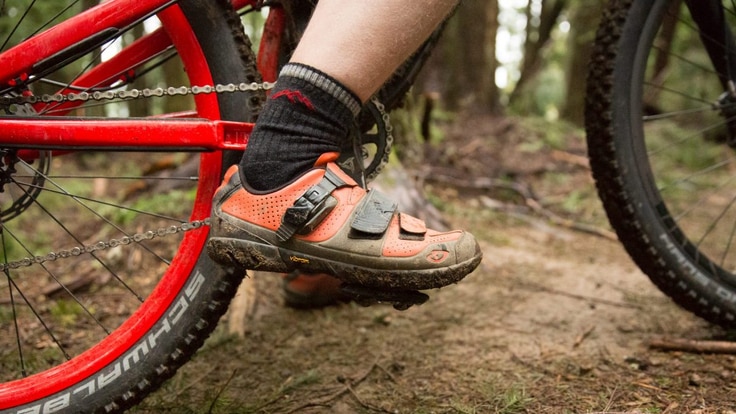If you enjoy riding your bike but don't consider yourself a hard-core cyclist (yet), you might wonder if you need cycling-specific socks. Can't I just wear basic workout socks and be done with it? Yes, you absolutely can. But, just as there are welcome details like subtly padded zones in hiking socks, certain characteristics in cycling socks make them more comfortable when you ride.
Generally, bike socks have the following features:
- Cycling socks are thin and fit closely because bike shoes fit snugly and can't comfortably accommodate thick, loose-fitting socks.
- Cycling socks, like socks for most aerobic activities, are made of wicking, quick-dry materials to minimize discomfort as your feet sweat.
- Many cycling socks include mesh vents on top to help feet stay cooler.
Cycling socks are thin and snug.
Cycling shoes are designed to be stiff so that the effort you put into leg movement efficiently transfers into pedal movement (a shoe that flexes would divert some pedaling energy into shoe movement). In addition, cycling shoes are designed to fit snugly so that no energy is dissipated through the movement of your foot inside your shoes. For this reason, the socks that go into the cycling shoes need to be snug as well.
Some cycling socks even have compression bands (around the arches), which are designed to provide a more supportive fit. Whether you want compression bands in your socks, though, is less a matter of any noticeable performance advantage and more a matter of whether you like the feel of socks that are built that way.
Cycling socks wick away sweat.
Sweaty feet, in addition to being generally uncomfortable, are more blister-prone. So serious cycling socks are made out of synthetic materials like nylon or polyester, both of which wick moisture and dry quickly. If you prefer natural fibers, you can get merino wool cycling socks instead, which offer similar moisture management performance, plus are naturally resistant to odor buildup. Cotton socks are not a good choice because they retain moisture.
Cycling socks are breathable.
Mesh ventilation panels, typically found along the tops of cycling socks, boost breathability and comfort. Many cycling socks also have flat-seam toes to prevent chafing.
Cycling socks' heights vary.
The height of your cycling socks is largely a matter of personal preference. As long as the sock comes up higher than your shoe, it can work. (Some cyclists even decide sock height based on where they want their tan lines.) Performance-focused cyclists (ones that shave their legs) might go with higher socks because of a slight aerodynamic advantage.
If you're a mountain biker, then you'll probably want a pair of higher, more durable socks to help protect your ankles and lower legs from brush, gravel and dirt.
Do you need thicker cycling socks in the winter?
Thicker socks won't work unless you have shoes that will accommodate them. So, if winter conditions are severe where you live, then you might consider getting both winter cycling shoes and thicker socks to wear inside those shoes. If you're not gearing up to ride in severely cold conditions, then cycling shoe covers for fall and winter riding are your better bet.

